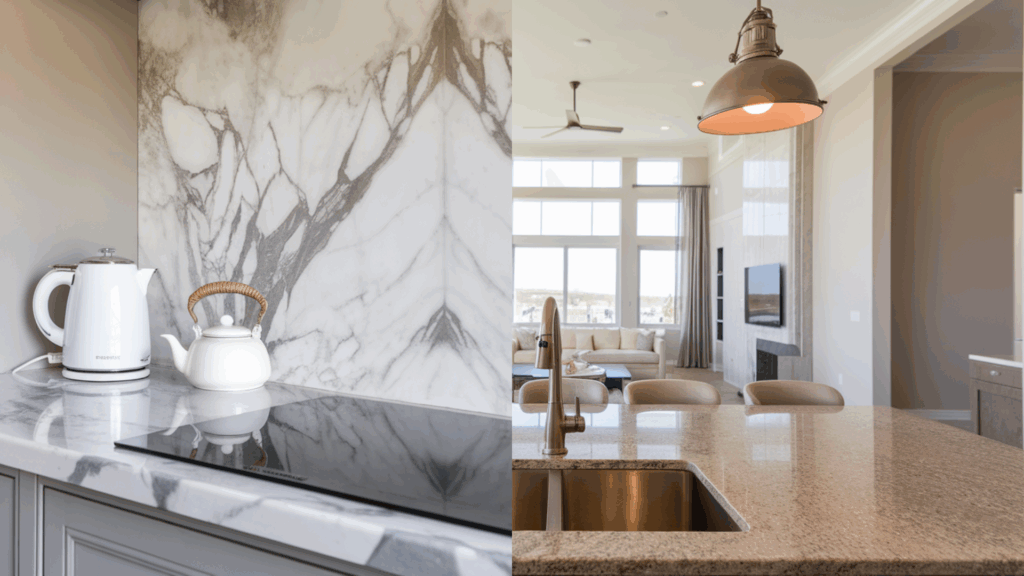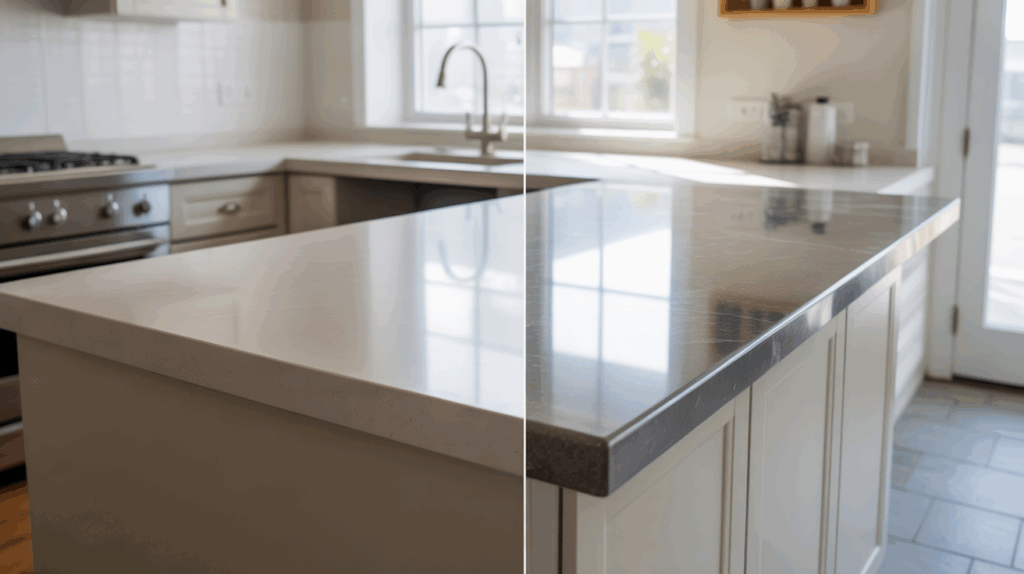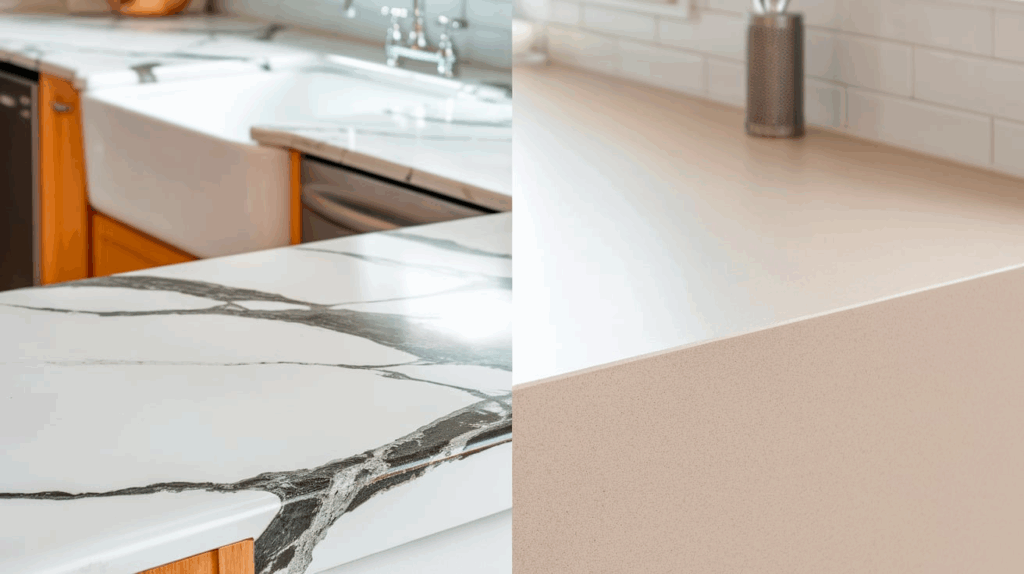When I remodeled my bathroom, I thought picking a countertop would be easy, until I had to decide between solid surface and quartz. At first glance, they seemed similar: sleek, durable, and stylish.
But once I dug deeper, I realized they were two very different materials.
That’s when I started comparing everything: durability, cost, upkeep, design options, and how each one fit into my daily routine and design goals.
If you’re stuck between solid surface and quartz, this guide is for you. I’ve gathered everything I learned during my own search, so you can make an informed choice without feeling overwhelmed.
Let’s break it down together, no guesswork, just clear info and personal insight to help you choose the right surface for your kitchen or bath.
What is Solid Surface?
Solid surface is a crafty invention born from a special mix of ingredients. Imagine a material that’s part science, part art. I’m talking about a blend of acrylic resin, polyester, and natural minerals that comes together like magic.
When you first see a solid surface countertop, you’ll notice something unique. The color isn’t just a surface coating – it runs deep. I mean through the entire thickness of the material.
Got a scratch? No sweat. You can buff it out like it never happened. Brands like Corian® are the rockstars of this material world. Let’s see what sets them apart:
- Non-porous design
- A hygienic surface that stays clean
- Comes in a rainbow of colors and patterns
- Can be shaped into mind-bending curves
These countertops are thermoformable. That means that they can be molded into crazy cool shapes. Curved kitchen island? Integrated sink? Bring it on.
The manufacturing process is like culinary chemistry. Manufacturers mix natural minerals with special resins, heating and molding them into sheets that look absolutely seamless. No visible joints. No awkward breaks.
When you’re choosing a countertop, solid surface offers something extraordinary. It’s not just a surface – it’s a solution, practical, flexible, and unique.
Pro tip: Touch a solid surface countertop. Feel that smooth, matte finish? That’s the magic I’m talking about.
What is Quartz?
Quartz is nature’s masterpiece, reimagined by human engineering. Imagine taking 90–95% crushed natural quartz and changing it into something extraordinary.
Quartz is a material that’s part natural stone, part scientific marvel. I’m talking about a countertop that combines crushed quartz with resin and pigments to create something absolutely incredible.
Here’s the scoop on why quartz is a kitchen superhero:
- Incredibly durable surface
- Harder than solid surface materials
- Stain-resistant champion
- Glossier finish that catches the light
Quartz countertops are like chameleons. They can mimic marble, granite, or even concrete. Want the look of classy stone without the headache? Quartz has your back.
The creation process is like culinary science. Manufacturers take natural quartz, crush it into tiny pieces, then mix it with special resins and pigments. The result? A surface that’s tough as nails but looks drop-dead gorgeous.
When you’re choosing a countertop, quartz offers something remarkable. It’s not just a surface – it’s a solution for busy kitchens that demand both beauty and brawn.
Pro tip: Touch a quartz countertop. Feel that smooth, glossy finish? That’s engineering meets artistry.
Quartz vs. Solid Surface: Key Differences

Understand how quartz and solid surface countertops differ in durability, appearance, heat resistance, maintenance, and value, so you can confidently choose the best fit for your lifestyle and space.
1. Durability and Strength
- Solid Surface: More prone to scratches and dents, solid surface suits moderate-use areas. Its redeeming factor is that minor damage can often be sanded or repaired, making it user-friendly and suitable for low-traffic areas.
- Quartz: Quartz is incredibly tough, thanks to its dense construction. It resists cracking and chipping. Perfect for busy kitchens or homes with kids, quartz provides long-lasting performance with little need for repairs.
2. Appearance and Style
- Solid Surface: Offers a smooth, matte appearance. Ideal for modern designs, it allows for built-in sinks and backsplashes. Its consistent color and finish provide a clean, contemporary look throughout the space.
- Quartz: Mimics the look of natural stone, featuring beautiful veining and consistent patterns. Available in polished finishes, quartz fits well in both traditional and contemporary spaces.
3. Heat Resistance
- Solid Surface: Sensitive to high heat, it can scorch or discolor if exposed to hot pots or pans. Always use a trivet or pad to protect the surface from permanent thermal damage.
- Quartz: Quartz handles moderate heat well but isn’t heatproof. High temperatures can damage the resin, so hot cookware should always rest on trivets to maintain surface integrity.
4. Scratch Resistance
- Solid Surface: Easier to scratch than quartz, especially with sharp tools or abrasives. However, light scratches can be sanded down at home, making upkeep manageable for most homeowners.
- Quartz: Highly resistant to everyday scratches, making it great for cooking and daily use. While not indestructible, it rarely needs repair and holds its finish long term.
5. Maintenance and Cleaning
- Solid Surface: Non-porous and easy to clean with soap and water. Over time, dull spots may form but can usually be restored with light buffing or refinishing.
- Quartz: Quartz requires minimal maintenance, no sealing, staining, or special products needed. A wipe with mild soap keeps it looking clean and bright, even in busy kitchens.
When selecting a countertop, homeowners face a critical decision between quartz and solid surface materials.
Each option brings unique strengths and limitations to your kitchen or bathroom design. Let’s take a quick look at the differences between quartz and solid surface.
| Feature | Solid Surface | Quartz |
|---|---|---|
| Material Composition | Man-made blend of acrylic, polyester resins, and natural minerals | Engineered stone is made from 90–95% crushed quartz and resins |
| Appearance | Smooth, matte finish with seamless designs and subtle patterns | Glossy or matte, mimics natural stone with uniform veining or consistent color |
| Durability | Softer, prone to scratches, but repairable by sanding | Extremely durable and scratch-resistant; handles daily wear well |
| Heat Resistance | Low heat tolerance; can scorch from hot pans | Moderate resistance; resins can be damaged by high heat, use trivets |
| Scratch Resistance | Scratches more easily; refinishing is possible | Highly resistant to scratches; maintains finish with minimal effort |
| Maintenance | Easy to clean; no sealing needed; occasional buffing restores finish | Low maintenance; no sealing, staining, or special cleaners required |
Which One Should You Choose: Solid Surface or Quartz?
Choosing between solid surface and quartz countertops really comes down to how you live and what you love.
If you’re after a clean, seamless look with integrated sinks and soft lines, solid surface might be the better fit, especially in bathrooms or lower-traffic kitchens.
It’s easy to maintain and can be repaired if scratched. But if your space needs something tougher that resists everyday wear, spills, and scratches, quartz is the way to go.
It gives you the visual richness of natural stone without the upkeep, making it great for busy families or entertainers.
Both materials come in beautiful colors and finishes, so sample a few and see how they look under your lighting. The right choice is the one that fits your space, your habits, and your style.
Cleaning Tips for Quartz and Solid Surface Countertops

Keeping quartz and solid surface countertops clean is simple with the right approach. These surfaces are designed for low maintenance, but following a few best practices can extend their life and beauty:
- Use a soft cloth with mild soap and warm water for regular cleaning. This works well on both surfaces.
- Avoid harsh chemicals like bleach, acetone, or strong solvents that can damage the finish or dull the surface.
- Don’t use abrasive pads or scrubbing tools, as they may scratch or wear down the surface over time.
- Wipe up spills quickly, especially acidic or deeply pigmented ones like coffee, wine, or tomato sauce.
- For tougher stains, use a pH-balanced cleaner on quartz or a baking soda paste on a solid surface.
- Solid surface scratches can be lightly sanded and buffed out, offering easy repairability.
- Always use trivets or hot pads under hot pots or pans to prevent thermal damage.
Conclusion
Choosing between quartz and solid surface countertops really depends on your needs, habits, and style preferences.
When I renovated my space, I chose solid surface for my bathroom because I wanted that seamless, clean look with an integrated sink. For the kitchen, I went with quartz; it’s strong, beautiful, and stands up to daily cooking.
No choice is wrong here. It’s about what matters most to you: durability? Cost? Appearance? Think about your lifestyle and how much use your countertops will get.
Still unsure? Get samples, look at them in your space, and trust what feels right. And if you’ve got questions, I’m happy to help. Drop a comment or message me anytime.
Let’s find the surface that fits your home beautifully.

